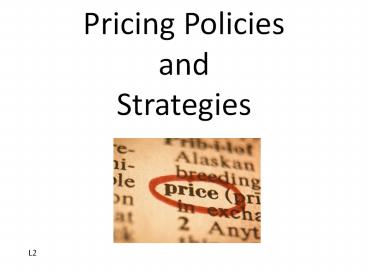Pricing Policies and Strategies - PowerPoint PPT Presentation
1 / 18
Title: Pricing Policies and Strategies
1
Pricing PoliciesandStrategies
L2
2
Pricing Policies
- One-price policy
- Flexible-price policy
3
One-price policy
- Used by most retail stores
- Employs price tags and signs
- No deviation permitted
- Simple, no haggle
4
Flexible-price Policy
- Negotiated
- Avoided by most retailers due to legal issues
- Expected and used for
- Cars
- Real Estate
- Some furniture
- Fine jewelry
- Products that are sold using credit ratings
5
Pricing Policies based on Product life stage
- Skimming Pricing
- Penetration Pricing
6
Skimming Pricing
- Introduction stage of product life cycle new
product - High price
- Covers initial costs
- Targeted toward trend setters
- Price to be lowered later
- Disadvantages
- Attracts competition
- May price too high
7
Penetration Pricing
- Used to penetrate an existing market
- Low price
- Effective for products with elastic demand
(price-sensitive) - All marketing must move quickly
- Blocks or out-sells competition for short time
- Disadvantage not effective if product not in
high demand
8
PRICINGStrategies
- Cost-based
- Demand-based
- Competition-based
9
1. Cost-Based Pricing
- Markup Pricing
- Cost-Plus Pricing
10
Markup Pricing
- Markup difference between price of an item and
its cost - Usually expressed as a
- Used for goods acquired for resale
- wholesalers and retailers
11
Cost-Plus Pricing
- Used by manufacturers and service businesses
- Used for individual goods and services
- More customer-specific
- All fixed and variable costs are calculated, then
desired profit added
12
PRICINGStrategies
- Cost-based
- Demand-based
- Competition-based
13
2. Demand-Based Pricing
- Based on consumer perception of product value
- Effective when product demand is inelastic
- Few or no substitutes
- Necessity
- Effective when demand is based on time and/or
place - Matinee theater tickets vs. evening tickets
- Dugout vs. nosebleed seats
14
3. Competition-Based Pricing
- Prices based on what the competition does
- Not based on cost or demand
15
Competitive Bid Pricing
- Determining the price for a product on the basis
of bids submitted by competitors - Most govt agencies required to accept lowest bid
for desired product - Companies bid low and take lower profit in order
to gain contract
16
Going-rate Pricing
- Used by most companies in some way
- Used by businesses whose competing products are
very similar - Company with highest market share usually sets
the price - Competing companies may
- Price below
- Price above
- Price at
17
In reality, companies will use a combination of
these 3 strategies not just one
18
Cost-based pricing helps determine the price
floor the lowest price it can go to make a
profit (remember
break-even point)
Demand-based pricing helps establish a price
range price floor (cost) to price ceiling
(consumer perceived value)
Competition-based pricing allows company to
determine how the price selected relates to the
competition































